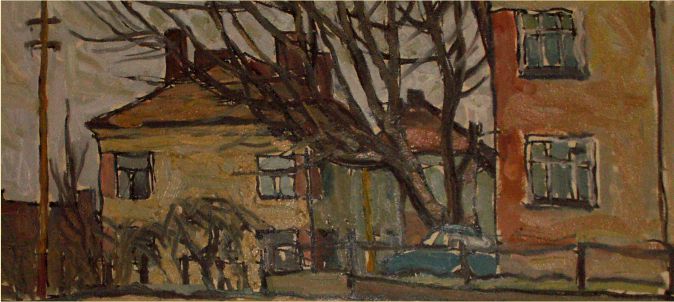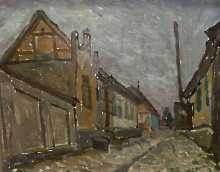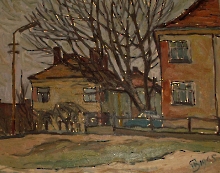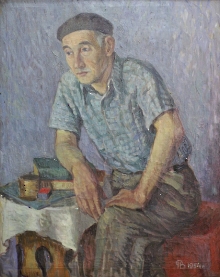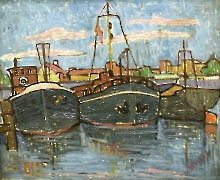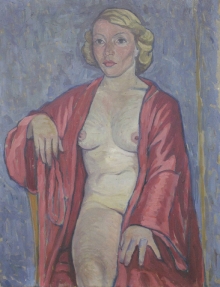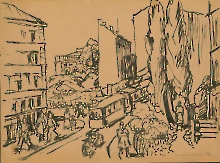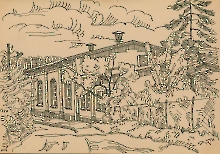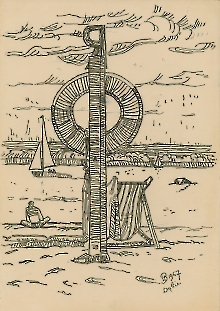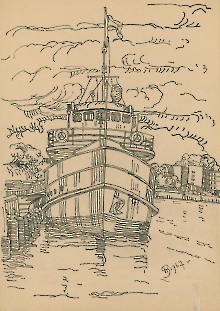"Colours of Melancholy", a temporary exhibition of works by Paweł Bałakirew, will be available at the National Museum in Szczecin - the Szczecin History Museum (ul. Księcia Mściwoja II 8) from September 19th 2023.
There were visual artists among the settlers arriving in Szczecin after the end of the Second World War. Initially small in number, they played a special role in the cultural development of West Pomerania. Representing different art schools and coming from different areas of pre-war Poland, the visual artists became the first artistic community to unite in Szczecin in 1945. This took place within the local branch of the Association of Polish Artists and Designers (ZPAP). In 1946, it was joined by Paweł Bałakirew (1914-1968), a young Vilnius artist specialising in easel painting and drawing.
Showing a talent for the visual arts from an early age, he wanted to study painting in his youth. From 1933, he studied at the Academy of Fine Arts in Paris, and in 1934 he presented his work as part of an exhibition of young artists in Montparnasse. In 1935, he returned to Vilnius, where two years later he began studying painting at the Faculty of Fine Arts. He continued his education even during the war, while also taking an active part in defence battles.
His post-war fate was tied to Szczecin, where, apart from the ZPAP, he joined the "13 Muses" Club of Creative Associations and Societies. The most outstanding Szczecin artists of the time, such as Guido Reck, Henryk Karniej, Zenon Kononowicz, Łukasz Niewisiewicz, Adam Pohorecki, Jan Powicki and Tadeusz Powidzki visited his studio. In the early days, like many artists in Szczecin, he earned money by making theatre decorations, among other things. However, he continued to paint in the open air, taking as his theme mainly city and maritime landscapes. He also did not shy away from creating portraits of people from his immediate environment and of Szczecin actors in stage costumes. He took part in numerous individual and collective exhibitions. He took artistic trips to Bulgaria and the Netherlands, which resulted in a number of cityscapes and portraits of the local people.
His output referred to Post-Impressionism, and in his technique he used, apart from oil paint, tempera, watercolour, pencil, charcoal and lavage ink. His colour scheme was dominated by muted greens, oranges and browns. Juxtaposed with the sadness and lyricism that characterise the artist's works, they became the peculiar colours of melancholy.
As a result of redefining the borders after the end of the Second World War, the lands east of the Oder and Nysa Łużycka rivers became part of the Polish state.
Representing various art schools, as well as different professional experiences, the environment of artists played a special role in the process of cultural development of West Pomerania.
Paweł Bałakirew (1914–1968) from Vilnius, whose fields were easel painting and drawing, was a kind of its icon. He developed his artistic interests initially at the Franciszek Smuglewicz Courses of Drawing and Painting and in 1933 he began studying at the Académie des Beaux-Arts in Paris, having previously participated in, among others, an exhibition of works by young artists in Montparnasse (1932). In 1935 he returned to Vilnius, where he was called up for military service. After completing it, in the years 1937–1939, he studied at the Faculty of Fine Arts of the University of Stefan Batory in Vilnius, developing his artistic skills under the direction of, among others, Jerzy Hoppen, Marian Morelowski and Stefan Narębski. After the outbreak of the Second World War, he actively participated in the defensive operations, after which he continued his studies of painting at the Academy of Fine Arts in Vilnius (1940–1941 and 1944).
In May 1946, Bałakirew settled in Szczecin with his wife Tatiana Polanina and their three children. Almost immediately, he became a member of the local branch of the Association of Polish Artists and Designers, established a few months earlier. Then he was also involved in the activities of the Club of Creative Associations "13 Muz", which implemented numerous culture-forming initiatives after the war. In addition to creating in the open air, Balakirev prepared theatrical scenography, including the production of George Dandin, or the Abashed Husband by Molière, directed by Jerzy Szaniawski, staged in 1947 for the Theatre of Musical Comedy in Szczecin. At the same time, he collaborated with "Głos Szczeciński" daily newspaper. There he had his own column entitled From Paweł Bałakirew's File, where profiles of Szczecin theatre actors drawn by him were published.
His works included mainly landscapes and portraits inspired by Post-Impressionism, as well as drawings, especially in washed ink. His topics were churches, streets, suburbs and alleys of the demolished Szczecin, as well as ships, fishing boats, shipyards and ports by the river Oder and Baltic Sea. He made his observations through frequent wanderings around the city and its vicinity, often lasting from morning to late evening. His portraits, in turn, depicted his wife, his children and people from his close surroundings. He painted with broad brushstrokes, focusing his attention on the colours. Among them, delicate greens, warm browns and shades of orange dominated. Bałakirew's works were characterized by a specific melancholy, sadness, lyricism and emotionality. They faithfully reflected the reality surrounding him and the state of mind of the author himself, who was in poor health. Paweł Bałakirew managed to transfer his passion for painting to his younger, beloved son Oleg. He also became a painter and in the 1970s he was one of the most interesting and recognizable artists in Szczecin. However, his flourishing work was interrupted by his premature death. Both artists are buried at the Central Cemetery in Szczecin.
- Pejzaż portowy z Mostem Długim (dawniej Lange Brücke) w tle, 1966, ołówek, pióro, tusz, papier
- Author: No Data
